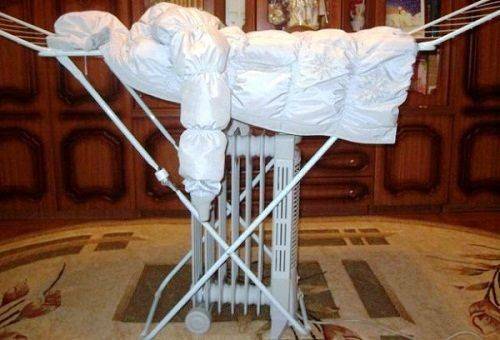Contents:
- How to properly wash clothes from bio-fluff in a washing machine?
- Rules for hand washing
- Features of care for filler
Modern textile industry instead of the usual skin and fur increasingly uses synthetic fabrics and fillers. A special place in the list of similar materials was won by bio fluff. This light and soft insulation is used for stuffing down jackets, winter trousers and other types of warm clothes.

Unfortunately, many owners of practical and convenient products forget that the artificial component needs a rather specific care. Only if you properly clean whimsical things and set the right parameters when processing them in a washing machine, you can count on the long service of the object and the preservation of its attractiveness.
How to properly wash clothes from bio-fluff in a washing machine?
Washing of products from bio-fluff in the machine is completely permissible, but only when basic recommendations are observed, the material is not deformed, remains safe and hypoallergenic, retains its volume and will also effectively retain heat.

Even the volumetric down jacket will not suffer during processing, if you remember the following points:
- The washing mode can only be manual or delicate, the temperature should not exceed 40 ° C.
- Spin is better to be turned off at all, or set the indicator at 600 rpm.
- If you plan to use an air conditioner, then fluff will have to be rinsed additionally.
- It is better to leave dry powder as the main detergent. At this temperature, washing with the use of liquid or gel-like products will give the best result. And such a problem as the appearance of plaque or divorce will be avoided.
- Bio fluff is prohibited from subjecting to pre-soaking! Even a short stay and standing water will negatively affect the artificial composition. If there are serious contaminants on the surface of the product, additional local cleaning should be carried out using profile stain removers or laundry soap.

Taking into account the fact that objects of everyday life and clothes that are filled with bio fluff are used by consumers very actively, cleaning will have to be done quite often. Machine washing is not the only option, manual exposure to artificial filler can be no less effective, but a safer alternative.
Hand-washing rules
Hand-washing can be used not only for frequent product handling. Sometimes this is the only option for exposure to a bio product, for example, if the thing is so large that it does not fit into the drum. In this case, you need to act according to the following scheme:
- In a bath with warm water, we dilute a liquid powder or a gel for washing. The temperature of the liquid should initially not be more than 40 ° C, despite the fact that it will cool down fairly quickly. Violation of this rule can lead to the destruction of useful enzymes and a decrease in the quality of the final result.
- First thing you need to beat your hands well, so that the fluff becomes more friable. We put the product in water and again it is gently whisked, achieving uniform wetting.
- Without waiting, immediately proceed to the processing of contaminants. Usually no additional application of soap solutions or stain removers is required, the brush and detergent are good at even the most resistant stains.

Advice: It is highly recommended not to squeeze artificial fluff with your hands during the cleaning process. From this he will gather in lumps, which in the future will be difficult to break. On the contrary, it is better to constantly shake things, moving from one site to another.
- After the desired result is achieved, drain the water, and put the clean object on a special stand or suspended, so that the glass soapy water.
- Having got rid of the main moisture several times with a hollow product, allowing the fluids to drain freely after each approach.
It only remains to dry the object and return it to its original shape. If the cleaning procedure did not give the desired result, you can try washing the thing in the typewriter or handing it to a dry cleaner.
Features of care for the filler
Dry the bio fluff on a horizontal surface, podsteliv under the product material with good absorbent properties. Substrate will have to be changed several times as it gets wet, otherwise the moisture will return to the filler. In addition, the object must be regularly turned over, spread, slightly shaken and even whisked intensively.
Few people know that such fluff is not afraid of iron. You just need to set on the machine a mode that corresponds to the type of outer fabric, and iron all available surfaces. In extreme cases, you can do with steaming, this also does not harm the filler and will not reduce the level of its functionality.

Special attention should be paid to the process of packaging and storage of things from bio-fluff, in particular after washing. Use vacuum bags is strictly prohibited, this is fraught with deformation of the filler, which is difficult to combat even professionals. Collapse and chop such things, too, is not worth it. It's better to just hang them in the closet, having previously straightened out all the creases and creases. Pressure on the filler is better not to create.
Despite such troublesome care, the filler has a virtue that eclipses all the drawbacks - it dries very quickly. Only 3-4 hours of torment and favorite down jacket can be worn and without fear of leaving it in the frost.


